Spectrophotometric Method Development for Simultaneous Estimation for Combination of Rosuvastatin and Curcumin
Nagma Najat*, Bina Gidwani, Astha Verma and Neha Dubey
Shri Rawatpura Sarkar Institute of Pharmaceutical Sciences, India
Submission: August 14, 2018; Published: October 22, 2018
*Corresponding author: Nagma Najat, Assistant Professor, Shri Rawatpura Sarkar Institute of Pharmacy, Kumhari, Durg, India.
How to cite this article: Nagma Najat, Bina Gidwani, Astha Verma, Neha Dubey. Spectrophotometric Method Development for Simultaneous Estimation for Combination of Rosuvastatin and Curcumin. Glob J Nano. 2018; 4(3): 555638. DOI: 10.19080/GJN.2018.04.555638
Keywords: Rosuvastatin; Calcium salt; Hepatic; Inflammation; Cholesterol levels
Abbrevations: RSV: Rosuvastatin; VLDL: Very Low-Density Lipoprotein; LDL: Low Density Lipoprotein; LDL: Low-Density Lipoprotein-Cholesterol;HDL: High-Density Lipoprotein–Cholesterol
Introduction
Rosuvastatin (RSV) is the calcium salt of bis [(E)-7-[4-(4-fluorophenyl)-6-isopropyl-2-methyl (methyl sulfonyl) amino] pyrimidin-5-yl] (3R,5S)-3,5- dihydroxyhept-6-enoic acid]. RSV is a selective and competitive inhibitor of 3‐hydroxy‐3‐methylglutaryl‐ coenzyme-A (HMG‐CoA) reductase, the rate‐limiting enzyme that converts 3‐hydroxy‐3‐methylglutaryl coenzyme A to Mevalonate, a precursor of cholesterol. RSV is a member of the class of statins, used to treat hypercholesterolemia and related conditions and to prevent cardiovascular disease. It increases the number of hepatic LDL (Low Density Lipoprotein) receptors on the cell surface to enhance uptake and catabolism of LDL. Secondly, RSV inhibits hepatic synthesis of VLDL (Very Low-Density Lipoprotein), which reduces the total number of VLDL and LDL particles4.whereas curcumin is bis-α -β-unsaturated β-diketone with molecular weight 368.37 used in the treatment of inflammation [1].
Similarly, Curcumin has been shown to have over 600 specific health related functions in the body. It is important to maintain healthy cholesterol levels. Bad (LDL) cholesterol is known to deposit cholesterol in blood vessels, which can cause blockages in blood flow. Preventing proper blood flow can lead to a number of serious health concerns. Curcumin has been shown to exhibit anti-atherosclerotic action through protection against inflammation and oxidation, modulation of cholesterol homeostasis and inhibition of platelet aggregation. Studies have reported that curcumin is beneficial in lowering low-density lipoprotein-cholesterol (LDL) and raising high-density lipoprotein–cholesterol (HDL) while reducing lipid per oxidation. Animal studies in high fat-fed atherosclerotic rabbit model have revealed that curcumin effectively inhibit LDL oxidation and decreases cholesterol and triglyceroids levels [2].The role of Curcumin in hypercholesterolemia is shown in Figure 1.

In similar model, curcumin supplementation is also shown to significantly reduce early atherosclerotic lesions in thoracic and abdominal aorta, associated with reduced oxidative stress and decreased lipid peroxidation.Orally administered curcumin also decreases the formation of atherosclerotic lesions by 20% in apolipoprotein E and LDL receptor-Double knockout mice model of arthrosclerosis.
In human a study involving the administration of 500 mg of curcumin for 7 days to 10 healthy volunteers has shown a 29 %increases in HDL cholesterol, 12% decreases in total serum cholesterol and 33%decreases in total serum lipid peroxides. Administration of curcumin also reduces total and LDL cholesterol levels in patients with acute coronary syndrome. Another study has shown that 10 mg of curcumin given twice daily for 30 days significantly lowers the serum LDL and increases the HDL levels in healthy patients.
The objective of our study was to develop UV Spectroscopy method for the estimation of rosuvastatin and curcumin according to the ICH guidelines. Rosuvastatin and Curcumin were taken in combination in order to improve activity of therapeutic drug in adjacent to an herbal drug. There was no reported side effect or drug reaction on jointly administration of Rosuvastatin with curcumin administration. The standard was taken for both drugs at a concentration of 10μg/ml and was scanned between 200- 400 nm. On ultraviolet–visible spectrophotometric investigation maximum light absorption of both drugs occurred at 237.4 nm and 430nm.respectively. The structure of rosuvastatin and Curcumin is shown in Figure 2.
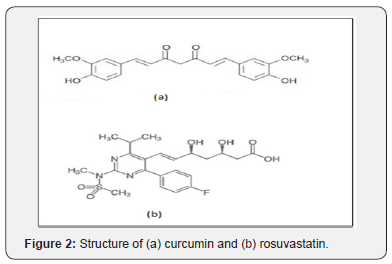
In fact, Curcumin could exert a synergistic effect when coadministration with Rosuvastatin. Hence a combined Drug delivery approaches was proposed for the development of a combination drug regimen[3].
Extensive literature has been done on study of rosuvastatin. Some of them are discussed as Reddy &Ashok etal.[4] in the year 2012 investigated the simultaneous determination of Rosuvastatin calcium and aspirin in tablets by Spectrophotometric method. Gajjr& Anuradha et al.[5]in the year 2010 explored the simultaneous estimation of Rosuvastatin and Ezetimibe by ratio spectra derivative Spectrophotometric method in their fixed dosage forms. In present work, simultaneous estimation of Rosuvastatin calcium with Curcumin is done by spectrophotometric method.
Materials and Methods
Materials
UV-visible double beam spectrophotometry (Shimadzu Model 1800) with matched quartz cell was used for all spectral measurements Reference standards of Rosuvastatin Calcium supplied by Torrent Research Center, Gandhi nagar, India with purity of 98.5% and 99.9% respectively. And curcumin was a gift sample obtained from RYM Exporters, New Delhi
Experimental methods
Selection of common solvent: After the solubility study of both drugs in different solvent, ethanol was confirmed as a common solvent for developing spectral characteristic [6].
Preparation of standard stock solution: Rosuvastatin (100mg) was transferred to a volumetric flask (100) having a reasonable quantity of ethanol and mixed properly. The volume was made up to 100ml with ethanol to have concentration of 1000 μg/ml of above solution was diluted to 1000 ml to give concentration of 10μg/ml .The same was designated as stock solution and was reserved for preparation of aliquots of various concentration 1,2,3,4,5,6,7,8,9,ml aliquots of stock solution was taken in a volumetric flask (10ml) and volume was madesolution was made up to10ml with ethanol to have concentration of 1,2,3,4,5,6,7,8,9, μg/ml. The absorbance was recorded for these concentrations at 237.4nm by using ethanol as a blank. The same done for curcumin [7]. The scan spectra and calibration curve of Rosuvastatin and Curcumin are shown in Figures 3a,b& 4a,b.
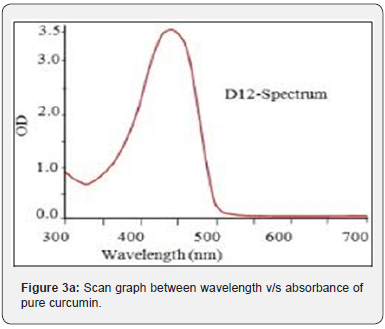
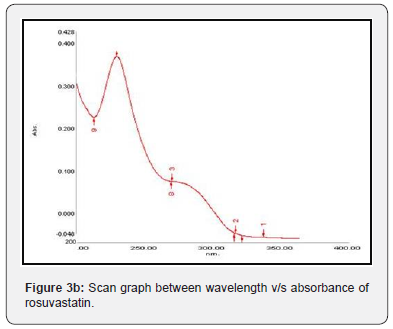
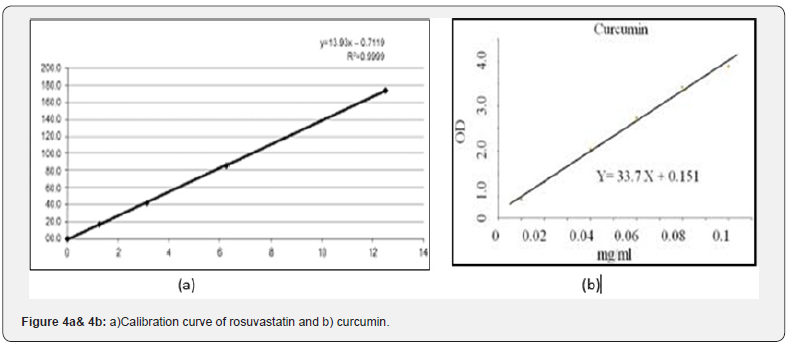
Method 1
Simultaneous equation method: From the standard stock solution,10ml of both the solution were taken and made it to final concentration of 10μg/ml. Absorbance was measured at both the wavelength (237.7nm and 430 nm) by using ethanol as blank. The readings were taken in triplicate. Absorbance of both the drugs was recorded at both the wavelength. The concentration was determined by using simultaneous equation method Kasture&Sharma et al.[8,9].
A1=ax1Cp+ay1Cs… (237.4nm)
A2=ax2Cp+ay2Cs… (430nm)
A1=Absorbance value of the sample solution at 237.4nm
A2=Absorbance value of the sample solution at 430nm
ax1 =Absorptivity of Rosuvastatin at 237.4nm
ax2=Absorptivity of Rosuvastatin at 237.4nm
ay1 =Absorptivity of curcumin at 430nm
ay2 =Absorptivity of curcumin at 430nm
Cp = Absorptivity of Rosuvastatin at 430nm
Cs=Absorptivity of Rosuvastatin at 237.4nm
Estimation of absorptivity (E1%, cm) values at selected wavelength: The Absorption (E1%, cm value) of Rosuvastatin and curcumin drugs was calculated at 237.4nm and 430 nm.
Method-2
Q-analysis (absorbance ratio method): Q-Absorbance method depends on the property that, for substances which obeys Beer’s law at all wavelength, the ratio of Absorbance at any wavelength is a constant value independent of concentration or path length. In the quantitative assay of two components in a mixture by the absorbance ratio method, absorbance is measured at two wavelengths: once being the λmax of one of the equal absorptivities of the two components i.e an iso-absorptive point[10].
Determination of iso-absorptive point and selection of suitable wavelength: An iso-absorptive point (a wavelength of equal absorptivity of the components) was determined by taking overlain spectrum of the solutions rosuvastatin and Curcumin (20ug/ml) in ethanol (95%) in UV range against the solvent blank. From the overlain spectra of the two drugs, it was found that rosuvastatin showed λmax at 319 nm and curcumin showed max at 351 nm, as iso-absorptive point was selected for extermination of drug simultaneously [11].
Study of Beer’s Lambert Law
The solution having concentration in range 1-10 for both rosuvastatin and curcumin were prepared in 0.1 N HCl using working standard solution. The absorbance of resulting solutions was measured at 275nm. Calibration curve were plotted at these wavelengths. Both the drugs obeyed linearity individually and combination within the concentration range of 1-10 μg/ml for both rosuvastatin andcurcumin [12].
Results and Discussion
The individual concentration range for Beer’s Lambert Law was found 1-10μg/ml for both rosuvastatin and curcumin was found to be at 237.4 nm and 430nm. The overlay spectra of rosuvastatin and curcumin are shown in Figure 5. The coefficient correlations were 0.999 and 0.999 respectively. Table 1 enlists the details of parameters obtained in simultaneous estimation. UV-scan of 10 μg/ml solution of rosuvastatin and curcumin combination showed the absorption maxima at 237.4nm and 430 nm. The simultaneous estimation was done to check the interference between both the drugs at λmax of one another.
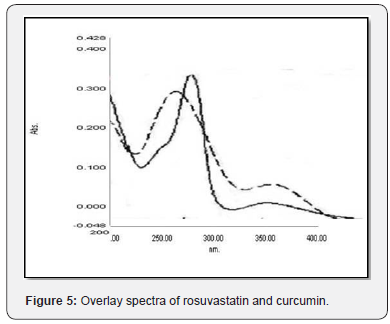

By substituting absorbance and absorptivity values of table in simultaneous equation C1 and C2 were calculated C1 = 9.78 μg/ml and C2 = 10 μg/ml. The percentage of rosuvastatin and curcumin recovered after the combination was found to be 97.8% and 100% respectively and indicating no interference between both the drugs. The Linearity regression equation method for curcumin and rosuvastatin in different concentration range. The correlation coefficient of these drugs was found to be close to 1.00 indicating good linearity. Hence proposed method can be used for routine analysis of these two drugs in combined dosage form. It is validated as per ICH guidelines.
Conclusion
Rosuvastatin and curcumin both drugs are important for hypercholesterolemia and related conditions and to prevent cardiovascular diseases. This reduces the overall delivery of cholesterol to the liver, thereby promoting the synthesis of LDL receptors and the subsequent reduction in serum LDL‐Cholesterol. UV-spectrophotometric method is selected for the analytical method development of Rosuvastatin and curcumin. The method is developed and validated. The proposed UV- spectrophotometric method was found very simple rapid and economical.However, the most important outcome of the simultaneous estimation is that we can formulate and analyze both drugs in combination for any suitable dosage form in a very safe and effective way. These methods can be used not only for above two combinations but also to a series of drugs having similar characteristic. This approach can be applied for the assay of the drugs in marketed formulation. Developed method can be used for routine analysis of these two drugs in combined dosage form.
References
- (2010) Indian Pharmacopoeia commisssion, Ghaziabad, Published by Government of India, Rosuvastatin calcium, pp. 2071-2073.
- Alwi I, Santoso T, Suyono S, Sutrinsa B, Suyatna FD, et al. (2008) The effect of curcumin on lipid level in patient with acute coronary syndrome. Acta Med Indones 40(4): 201-210.
- Heek MV, Farley C, Compton D, Hoos L, Davis HR (2001) Ezetimibe selectively inhibits intestinal cholesterol absorption in rodents in the presence and absence of exocrine pancreatic function. Br J Phamacol 134(2): 21-26.
- Reddy S Ashok (2012) Development of UV-Spectrophotometric method for the simultaneous determination of Rosuvastatin calcium and aspirin in tablets. Journal of global trend in Pharmaceutical Sciences 3(1): 542-549.
- Gajjr Anuradha K, Saha Vishal D (2010) Simultaneous estimation of Rosuvastatin and ezetimibe by ratio spectra derivative Spectrophotometric method in their fixed dosage forms. International Journal of Pharma Tech Research 2(1): 404-410.
- Doshi N, Avani Sheth, Tejas Patel, JB Dave, CN Patel (2010) Spectroscopic absorption factor method development and validation for estimation of rosuvastatin calcium and Telmisartan in solid dosage form. Journal of chemical and pharmaceutical research 2(3): 15-24.
- Vamsi KM, Gowri SD (2010) Spectrophotometric method for estimation of rosuvastatin calcium in pure form and pharmaceutical dosage form by using safranin o and methylene blue. Journal of chemistry extractive 4(1): 46-49.
- Kasture AV, Wadodkar SG, Mahadik KR, More HN (2006) Pharmaceutical analysis. (Volume II), Instrumental methods, Nirali prakashan, (4th Edt,) p. 169-181.
- Sharma YR (2002) Elementary organic spectroscopy. Principal and chemical application. In: S Chand and company Ltd, p. 64.
- Vogel A (2004) Elementary practical Organic Chemistry Part ǀǀ Organic Analysis. CBS Publishers & distributors, (2nd Edt,); pp. 241-247.
- Sweetman SC (2005) Martindale The Complete Drug Reference. Royal Pharmaceutical Society of Great Britain, 34: 843-841.
- Rajkondwar VV, Maini P, Vishwakarma M (2009) Characterization and Method Development for Estimation and Validation of Rosuvastatin calcium by UV-Visible Spectrophotometry. Int J Theo App Sci 43: 81-83.






























